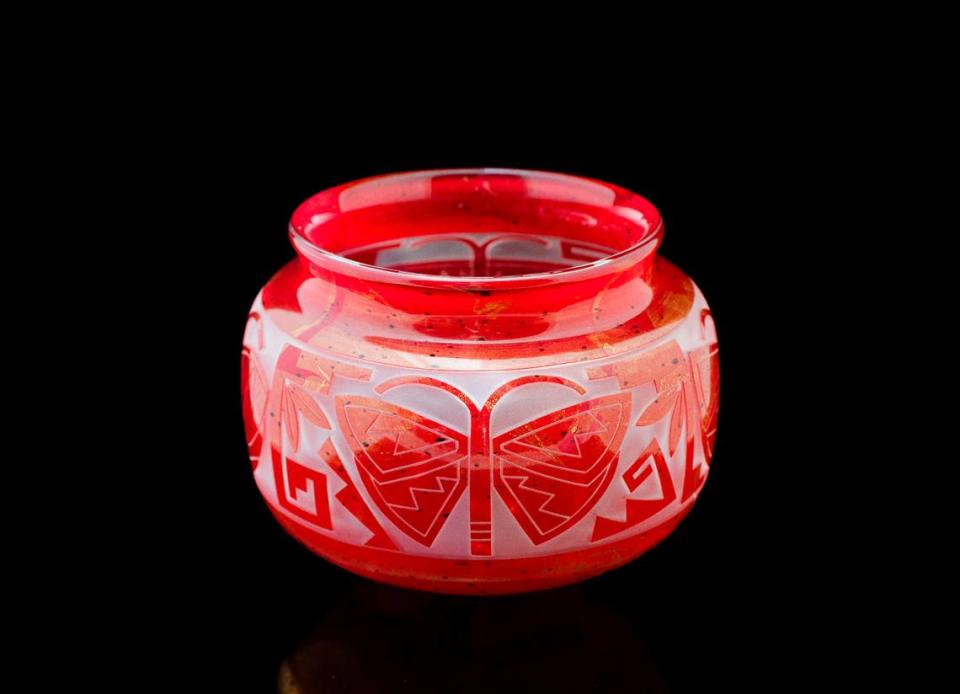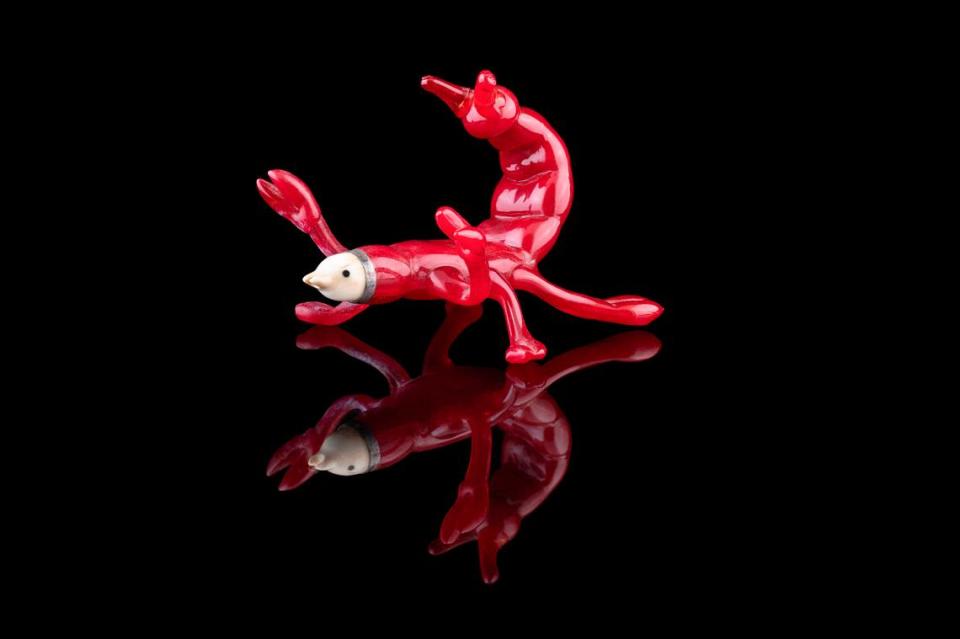‘Clearly Indigenous’ exhibit at WAM brings light to Native glass artists
- Oops!Something went wrong.Please try again later.
- Oops!Something went wrong.Please try again later.
For anyone who was awestruck and loved the glass sculptures in Preston Singletary’s “Raven and the Box of Daylight” exhibition that was at the Wichita Art Museum in 2020, get ready for round two.
More of Singletary’s work and that of 28 other Native American artists are among the approximately 120 pieces that comprise the “Clearly Indigenous: Native Visions Reimagined in Glass” exhibition that opens at WAM on Sunday, June 11, and continues through Sept. 10.
The exhibition is being billed as groundbreaking and first-of-its-kind since it brings together the works of several Native artists — some of whom are known for their work in other mediums — who draw from their traditional cultural iconography and designs to work in the nontraditional medium of glass. The artists represent 26 tribes and nations in the U.S. and Canada, including four from the Pacific Rim.
The glass sculptures on display include totems, vessels, ceremonial regalia, animal figurines, masks and other pieces. Some replicate designs like weaving or relief work that one might find in a Native basket or pottery.
“We are creating things based on tradition but translated into glass. That’s how I characterize it,” said Singletary in a recent interview with The Wichita Eagle from his Seattle studio. Singletary, who is Tlingit — pronounced either Tlin-git or Klin-kit, has four pieces in the exhibition, and he’s collaborated with other artists on 16 pieces that are on display.
WAM is the first stop for the touring exhibition, which originated at the Museum of Indian Arts and Culture in Santa Fe, New Mexico. Curated by Letitia Chambers, former CEO of the Heard Museum in Phoenix, the exhibition will tour through 2026.

“I think it’s a very comprehensive overview of Native American glass art,” Singletary said of the exhibition. “Letitia Chambers did a good job of reaching out to the known Native artists working in the material and included pretty much everybody.”
The exhibition includes works by Dale Chihuly, an internationally recognized glass artist considered a leader of the glass art movement. Visitors are likely familiar with Chihuly’s work since two of his pieces are permanently displayed at WAM: the Persian Seaform Ceiling, also known as the Chihuly Bridge, which can be viewed from the bottom in the lobby and walked across from above; and the Chihuly Chandelier that hangs in the Farha Great Hall.
According to Chambers’ book and exhibition catalogue, glass art in Indian County is the result of two movements coming together: the contemporary Native arts movement of the 1960s promoted by Lloyd Kiva New and the glass art movement influenced by Chihuly in the 1970s.
Chihuly co-founded the Pilchuck Glass School in Seattle in 1971. He later created a hot shop and glass art curriculum for the Institute of American Indian Arts in Santa Fe, where he taught for a semester. Kiva New co-founded the institute.
Pilchuck was where Singletary spent time learning to work with the medium and it’s also where he met and worked with Tony Jojola, who had become a regular assistant to Chihuly. Jojola eventually had a glass-making facility in Taos, New Mexico.
Jojola deserves a lot of credit, Singletary said, for influencing and bringing recognition to Native glass makers. When Singletary met Jojola, an Isleta Pueblo, he hadn’t connected to his cultural background as inspiration for his work. It was Jojola who planted the seed to create that connection.
“He was one of the earliest sort of pioneers” among Native American glass artists, Singletary said. Jojola died in December.
Singletary has since gone on to work extensively with indigenous artists, including those in New Zealand and Australia, sharing with them the possibilities of using glass as a medium for them to interpret their culture.
Among the artists he collaborated with whose works are included in “Clearly Indigenous” are potters Tammy Garcia and Jody Naranjo. Garcia’s Yellow Butterfly Cylinder sculpture is reportedly modeled after vessels found in archaeological digs.
After the success of Singletary’s exhibition at WAM in 2020 — which ended up being extended into January 2021 because the COVID pandemic prevented it from going on to the Smithsonian as scheduled, WAM decided to book the “Clearly Indigenous” exhibition.
“When we got wind of this one, we felt like it was the perfect follow-up,” said Tera Hedrick, WAM’s curator. “We had such a great time with ‘Raven and the Box of Daylight.’ WAM loved that show, Wichita loved that show, and we loved Preston.” Singletary attended the opening reception of the exhibition and gave a gallery talk at WAM in February 2020.
“Raven and the Box of Daylight” eventually made it to the Smithsonian’s National Museum of the American Indian and was featured on “CBS Sunday Morning” earlier this year, and it will be exhibited at the Oklahoma City Museum of Art from Nov. 11 through April 28.

WAM has scheduled several events in conjunction with the exhibition; more information on the events can be found at wam.org/events. The events include:
Gallery talk by Seattle-based artist Dan Friday, 2 p.m. Sunday, June 11. Free.
Culinar
y event featuring a menu curated by Chef Loretta Barrett Oden, 5:30-8:30 p.m. Thursday, June 15. Participants will enjoy a tour of the exhibition and a dinner that features a menu curated by Oden, an internationally renowned culinary authority on foods of America who started the Corn Dance Café in Santa Fe, New Mexico. Chef Katharine Elder of Elderslie Farm and WAM’s 1400 by Elderslie restaurant is preparing the meal. Cost is $155 per person, with a $20 discount for members.
Family ArtVenture, 11 a.m.-3 p.m. Saturday, July 22. The regular monthly program will include a performance by the award-winning Wichita War Dancer and glass-blowing demonstrations. Free.
Glass-blowing demo and gallery conversation, 9-11:30 a.m. Saturday, July 29, in collaboration with CityArts. The event starts at the glass-blowing studio at CityArts, 334 N. Mead, with a gallery talk following at WAM by CityArts glass instructor Aaron Jasso and WAM curator Tera Hedrick. Cost: $40 with a $10 discount for WAM members; advance registration required as space is limited.
Summer Film Series of movies about Native artists, curated by Rod Pocowatchit, founder and director of alterNative Film Festival. The films and dates are “Love and Fury” Friday, Aug. 4; “Through the Repellent Fence” and “Sweetheart Dancers” Friday, Aug. 18; and “Merate: How Mum Decolonized the Screen” Friday, Sept. 1. Event start time is 6:30 p.m.; tickets are $10 per person and free for WAM members.
“Clearly Indigenous: Native Visions Reimagined in Glass” exhibition
When: through Sept. 10. Gallery hours are 10 a.m.-5 p.m. Wednesday-Sunday, with extended hours on Friday until 9 p.m. Closed Mondays, Tuesdays and major holidays (June 19, July 4 & Sept. 4).
Where: Wichita Art Museum, 1400 W. Museum Blvd.
Admission: $12 for adults, free for WAM members, college students with ID and youth 18 and under; active-duty military and their families are free through the Blue Star Museum program
More info: 316-268-4921 or wam.org

